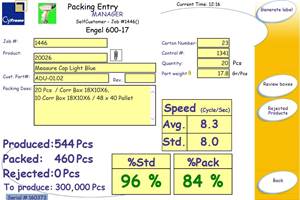'Classic' Blow Molding Tale: Taking on New Challenges
Classic Containers Inc., a family-owned blow molder in Ontario, Calif., has been supplying bottles and closures to the personal-care market for more than 20 years.
Classic Containers Inc., a family-owned blow molder in Ontario, Calif., has been supplying bottles and closures to the personal-care market for more than 20 years. It started in owner Manny Hernandez’s garage, printing on bottles and caps, and grew to a 100,000-ft2 bottle plant. One reason for Classic’s rapid growth is its boldness to try things others might not be willing to.
Classic makes bottles between roughly 0.5 oz and 32 oz using extrusion blow, injection blow, and injection stretch-blow molding. Its molds all have cavities on 100-mm centerlines, making them interchangeable. Classic runs monolayer and two-layer bottles with surface color or gloss layers in a number of resins—PP, HDPE, PET, and PETG. Classic also injection molds caps and closures, has a steam tunnel for shrink labels, and runs decorating equipment that can handle over 1 million bottle passes a day. Recently it switched to computerized QC to streamline processing.
But Classic hasn’t stopped accepting new technical challenges. When BP Polymers LLC, Rancho Santa Margarita, Calif., (kevin@bppolymers.com), came looking for a partner to develop blow mold tooling and processing know-how for its new nylon-based barrier additive for HDPE, Classic accepted.
The additive is called Quoral, and it works by creating impermeable overlapping platelets in the walls of a monolayer HDPE bottle to inhibit passage of gas. (BP produces it under license from a German firm.) It’s similar to the “Laminar Technology” behind DuPont’s Selar RB nylon 6 resins (dupont.com), introduced in the early 1980s. BP says Quoral uses a different formulation and compatibilizer. But like Selar RB, Quoral requires a special screw and tight temperature control. Quoral also doesn’t work well with stearate-based colorants. “Dark colors aren’t a problem, but lighter colors can be with zinc stearate,” says BP v.p. Kevin Callahan.
SIX MONTHS OF TESTING
Classic took six months last year to develop the process and special tooling needed for small monolayer barrier bottles using Quoral. Classic targeted a specific product—metal cans used to package adhesive for PVC pipe, one of the applications for which Quoral was first commercialized in Europe. This application hadn’t switched from metal to 5-layer HDPE/EVOH barrier containers because extrusion blown neck threads don’t fit tightly enough against the metal lid, so volatiles escape, BP’s Callahan says.
Classic tested Quoral on a dual-head Bekum extrusion blow molder making Boston round bottles in natural HDPE, which becomes a little cloudier with the barrier additive and a little rougher on the inside surface of bottles. Initially, solvent-filled containers experienced 6% weight loss after four weeks in a 122 F oven.
Classic found the tooling had to be modified with slightly wider pinch points and the temperatures were adjusted in order for Quoral to be properly distributed in the HDPE matrix. Eventually weight loss dropped to an acceptable 2%, and Classic is now ready to commercialize small monolayer barrier bottles.
Three years ago, BP commercialized barrier jerrycans with Quoral additive in partnership with Fischer S.A de C.V., a large blow molder in Cordoba, Mexico. Small barrier bottles, however, are more challenging to process because the ratio of surface area to volume is greater, making barrier performance more of a challenge and narrowing the margin for error in blending the additive into HDPE. BP exhibited both Classic’s small adhesive container and Fischer’s new F-style barrier bottle for the first time at Westpack in Anaheim, Calif., last month.
Related Content
Understanding the ‘Science’ of Color
And as with all sciences, there are fundamentals that must be considered to do color right. Here’s a helpful start.
Read More50 Years...600 Issues...and Still Counting
Matt Naitove marks his first half-century in plastics reporting, with a few of his favorite headlines.
Read MoreUse Interactive Production Scheduling to Improve Your Plant's Efficiencies
When evaluating ERP solutions, consider the power of interactive production scheduling to effectively plan and allocate primary and secondary equipment, materials and resources on the overall production capacity of the business and conclude that this is a key area that cannot be overlooked.
Read MoreSolve Four Common Problems in PET Stretch-Blow Molding
Here’s a quick guide to fixing four nettlesome problems in processing PET bottles.
Read MoreRead Next
For PLASTICS' CEO Seaholm, NPE to Shine Light on Sustainability Successes
With advocacy, communication and sustainability as three main pillars, Seaholm leads a trade association to NPE that ‘is more active today than we have ever been.’
Read MoreMaking the Circular Economy a Reality
Driven by brand owner demands and new worldwide legislation, the entire supply chain is working toward the shift to circularity, with some evidence the circular economy has already begun.
Read More




















